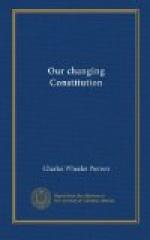[Footnote 1: Const., Art. I, Sec. 9, Clause 5.]
[Footnote 2: Id., Art. I, Sec. 8, Clause 1.]
[Footnote 3: Id., Art. I, Sec. 2, Clause 3. Sec. 9, Clause 4.]
The Constitution nowhere specified just what taxes were to be deemed “direct” (Madison in his notes of the Constitutional Convention records: “Mr. King asked what was the precise meaning of direct taxation? No one answd.")[1] or what kind of uniformity was intended by the provision that indirect taxes should be uniform, and more than a century was to elapse before either of these fundamental questions was finally settled. The answer to the latter question (that the term “uniform” refers purely to a geographical uniformity and is synonymous with the expression “to operate generally throughout the United States”) was given by the Supreme Court in the year 1900 in the celebrated case of Knowlton v. Moore,[2] and met with general approval. The answer to the question of what constitutes a direct tax within the meaning of the Constitution, given by the Supreme Court in 1895 in the Income Tax cases,[3] met with a different reception. The decision upset long-settled ideas, disarranged the federal taxing system, aroused popular resentment, and ultimately led to the enactment of the Sixteenth Amendment.
[Footnote 1: Farrand, “Records of the Federal Convention,” Vol. II, p. 350.]
[Footnote 2: 178 U.S., 41.]
[Footnote 3: Pollock v. Farmers Loan & Trust Co., 157 U.S., 429.]
The question had arisen early in the life of the Republic in the case of Hylton v. United States, decided in 1796.[1] This litigation involved the validity of a tax on carriages which had been imposed by Congress without apportionment among the states. Alexander Hamilton argued the case before the Supreme Court in support of the tax. The Court adopted his view and sustained the tax, holding that it was a tax on consumption and therefore a species of excise or duty. The Justices who wrote opinions expressed doubt whether anything but poll taxes and taxes on land were “direct” within the meaning of the Constitution. That point, however, was not necessarily involved and was not decided, though later generations came to assume that it had been decided.
[Footnote 1: 3 Dallas, 171.]
The tax on carriages was soon repealed and many years elapsed before the question came up again. After the Civil War broke out, however, the need of revenue became acute and various statutes taxing income without apportionment among the states were enacted by Congress. These met with general acquiescence. It was felt that they were emergency measures necessitated by the war, and they were in fact abandoned as soon as practicable after the war. A well-known lawyer, however (William M. Springer of Illinois), did not acquiesce and refused to pay his income tax, on the ground that it was a direct tax not levied in accordance




